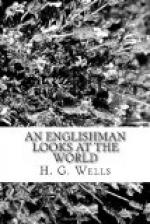Let me begin by pointing out that, in the more modern conceptions of logic, it is recognised that there are no identically similar objective experiences; the disposition is to conceive all real objective being as individual and unique. This is not a singular eccentric idea of mine; it is one for which ample support is to be found in the writings of absolutely respectable contemporaries, who are quite untainted by association with fiction. It is now understood that conceivably only in the subjective world, and in theory and the imagination, do we deal with identically similar units, and with absolutely commensurable quantities. In the real world it is reasonable to suppose we deal at most with practically similar units and practically commensurable quantities. But there is a strong bias, a sort of labour-saving bias in the normal human mind to ignore this, and not only to speak but to think of a thousand bricks or a thousand sheep or a thousand sociologists as though they were all absolutely true to sample. If it is brought before a thinker for a moment that in any special case this is not so, he slips back to the old attitude as soon as his attention is withdrawn. This source of error has, for instance, caught nearly the whole race of chemists, with one or two distinguished exceptions, and atoms and ions and so forth of the same species are tacitly assumed to be similar one to another. Be it noted that, so far as the practical results of chemistry and physics go, it scarcely matters which assumption we adopt. For purposes of inquiry and discussion the incorrect one is infinitely more convenient.
But this ceases to be true directly we emerge from the region of chemistry and physics. In the biological sciences of the eighteenth century, commonsense struggled hard to ignore individuality in shells and plants and animals. There was an attempt to eliminate the more conspicuous departures as abnormalities, as sports, nature’s weak moments, and it was only with the establishment of Darwin’s great generalisation that the hard and fast classificatory system broke down, and individuality came to its own. Yet there had always been a clearly felt difference between the conclusions of the biological sciences and those dealing with lifeless substance, in the relative vagueness, the insubordinate looseness and inaccuracy of the former. The naturalist accumulated facts and multiplied names, but he did not go triumphantly from generalisation to generalisation after the fashion of the chemist or physicist. It is easy to see, therefore, how it came about that the inorganic sciences were regarded as the true scientific bed-rock. It was scarcely suspected that the biological sciences might perhaps, after all, be truer than the experimental, in spite of the difference in practical value in favour of the latter. It was, and is by the great majority of people to this day, supposed to be the latter that are invincibly true; and the




